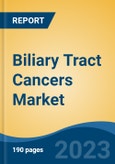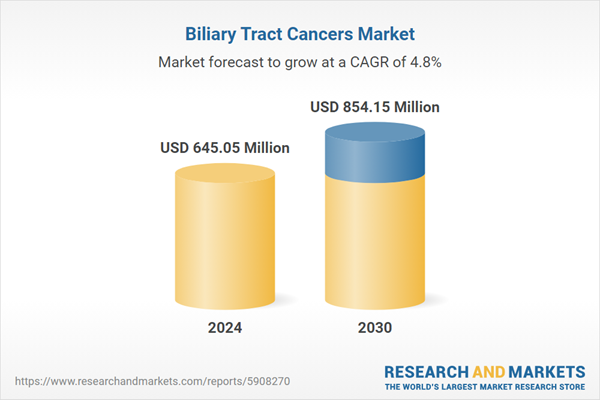Speak directly to the analyst to clarify any post sales queries you may have.
10% Free customizationThis report comes with 10% free customization, enabling you to add data that meets your specific business needs.
Biliary tract cancer, while relatively rare compared to some other cancers, has been on the rise in recent years. Factors such as changing lifestyles, increased obesity rates, exposure to environmental toxins, and specific risk factors like liver fluke infections have contributed to the increasing incidence of this disease. Understanding the prevalence of biliary tract cancer is crucial for market stakeholders to assess the potential patient population.
Key Market Drivers
Increasing Incidence and Prevalence of Biliary Tract Cancers (BTCs)
The increasing incidence and prevalence of biliary tract cancers (BTCs) are key market drivers that significantly impact the Global Biliary Tract Cancers Market. According to the Global Burden of Disease Study, the global age-standardized incidence rate (ASR) for biliary tract cancers (BTCs) is 2.5 cases per 100,000 individuals. However, incidence rates vary significantly based on tumor location (intrahepatic vs. extrahepatic cholangiocarcinoma, gallbladder cancer), geographic region, and gender, reflecting differences in genetic predisposition, environmental risk factors, and healthcare accessibility across populations.This rising trend is fueling demand for diagnostics, therapeutics, and supportive care solutions, creating lucrative opportunities for pharmaceutical companies, biotech firms, and healthcare providers. The growing number of diagnosed BTC cases worldwide is directly increasing the demand for treatment options. The Global Burden of Disease Study reported 139,500 deaths from biliary tract cancers (BTCs) in 2013, marking a 22% increase from the 115,400 deaths recorded in 1990.
This rise corresponds to an increase in the age-standardized mortality rate, from 2.3 deaths per 100,000 individuals per year in 1990 to 3.4 per 100,000 per year in 2013, highlighting a growing disease burden and the need for enhanced diagnostic and treatment strategies. With biliary tract cancers being aggressive and often diagnosed at advanced stages, the need for effective chemotherapy, targeted therapies, and immunotherapies is rising. Increased drug sales for existing therapies. Greater investment in clinical research and drug development. Expansion of treatment facilities and specialized cancer centers.
Key Market Challenges
Limited Awareness and Late-Stage Diagnoses
One of the foremost challenges facing the Global Biliary Tract Cancer Market is the limited awareness among the general population and healthcare providers regarding this particular cancer type. Biliary tract cancer often presents with non-specific symptoms, leading to delayed diagnoses. Many individuals and even some healthcare professionals may not be adequately familiar with these symptoms, which can include jaundice, abdominal pain, and unexplained weight loss.The lack of early detection can result in patients being diagnosed at advanced stages of the disease, when treatment options are more limited and prognosis is less favorable. This not only hampers patient outcomes but also reduces the potential market size for early-stage therapies and interventions.
Key Market Trends
Immunotherapy Revolutionizing Treatment Approaches
One of the most significant trends shaping the Global Biliary Tract Cancer Market is the emergence of immunotherapy as a promising treatment option. Immunotherapeutic agents, such as immune checkpoint inhibitors, have shown remarkable efficacy in various cancer types, including biliary tract cancer. These agents work by stimulating the body's immune system to recognize and target cancer cells, offering new hope for patients.The trend towards immunotherapy is driven by a growing body of clinical evidence supporting its effectiveness. Clinical trials have demonstrated prolonged survival rates and improved outcomes for patients with advanced biliary tract cancer. This has led to increased research and investment in immunotherapeutic approaches, with pharmaceutical companies developing novel drugs and therapies targeting this specific cancer type.
Key Market Players
- Bristol-Myers Squibb
- Eli Lilly and Company
- F. Hoffmann-La Roche Ltd.
- Johnson & Johnson Services, Inc
- Merck & Co., Inc.
- Novartis AG
- Pfizer Inc.
- Sanofi SA
- Bayer AG
- AstraZeneca plc
Report Scope:
In this report, the Global Biliary Tract Cancers Market has been segmented into the following categories, in addition to the industry trends which have also been detailed below:Biliary Tract Cancers Market, By Cancer Type:
- Intrahepatic Cholangiocarcinoma (ICC)
- Extrahepatic Cholangiocarcinoma
- Gallbladder Cancer
Biliary Tract Cancers Market, By End-User:
- Hospitals
- Specialty Cancer Centres
- Ambulatory Surgical Centres
- Others
Biliary Tract Cancers Market, By Region:
- North America
- United States
- Canada
- Mexico
- Europe
- France
- United Kingdom
- Italy
- Germany
- Spain
- Asia-Pacific
- China
- India
- Japan
- Australia
- South Korea
- South America
- Brazil
- Argentina
- Colombia
- Middle East & Africa
- South Africa
- Saudi Arabia
- UAE
Competitive Landscape
Company Profiles: Detailed analysis of the major companies present in the Global Biliary Tract Cancers Market.Available Customizations:
With the given market data, the publisher offers customizations according to a company's specific needs. The following customization options are available for the report.Company Information
- Detailed analysis and profiling of additional market players (up to five).
This product will be delivered within 1-3 business days.
Table of Contents
Companies Mentioned
- Bristol-Myers Squibb
- Eli Lilly and Company
- F. Hoffmann-La Roche Ltd.
- Johnson & Johnson Services, Inc
- Merck & Co., Inc.
- Novartis AG
- Pfizer Inc.
- Sanofi SA
- Bayer AG
- AstraZeneca plc
Table Information
| Report Attribute | Details |
|---|---|
| No. of Pages | 180 |
| Published | February 2025 |
| Forecast Period | 2024 - 2030 |
| Estimated Market Value ( USD | $ 645.05 Million |
| Forecasted Market Value ( USD | $ 854.15 Million |
| Compound Annual Growth Rate | 4.7% |
| Regions Covered | Global |
| No. of Companies Mentioned | 10 |









